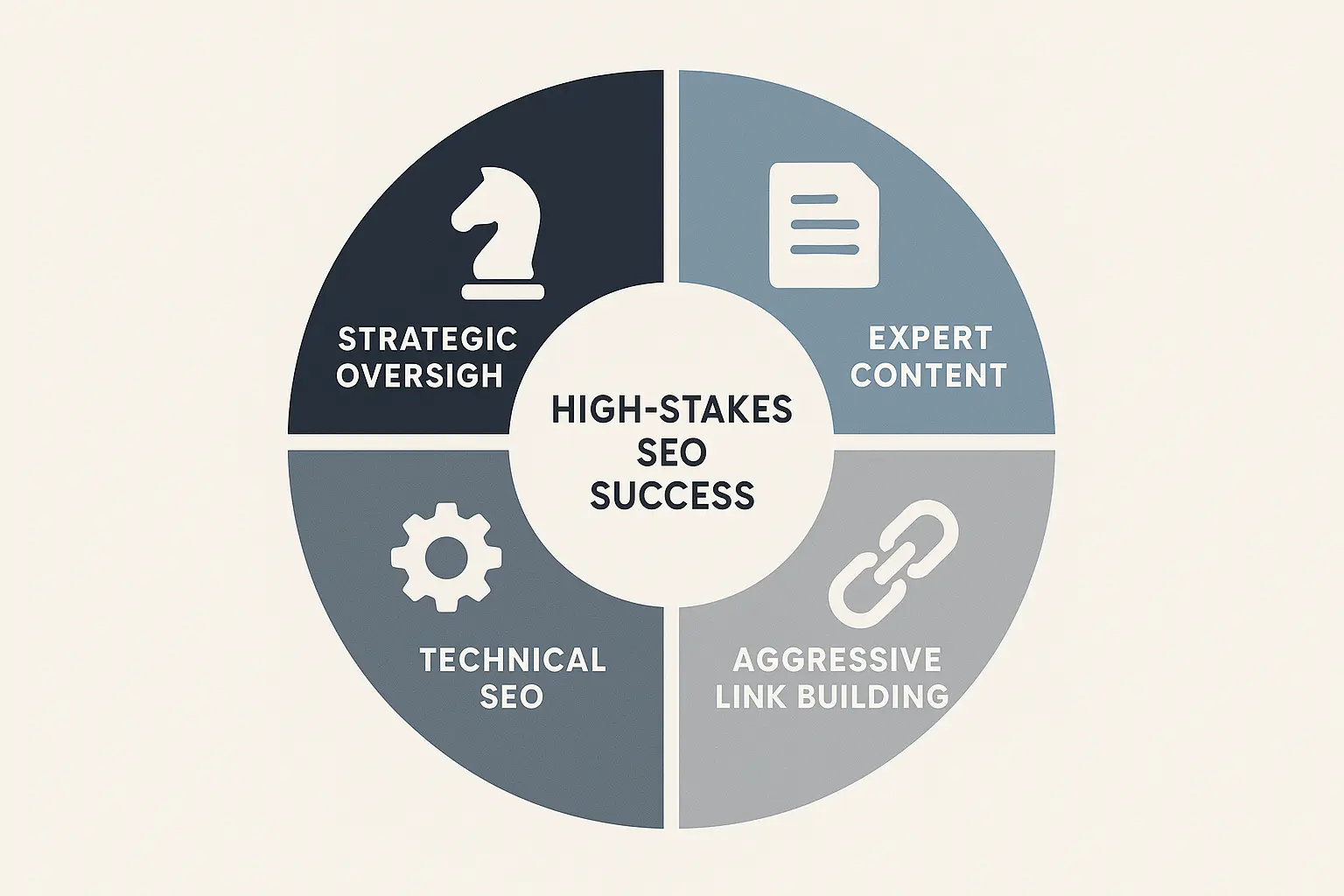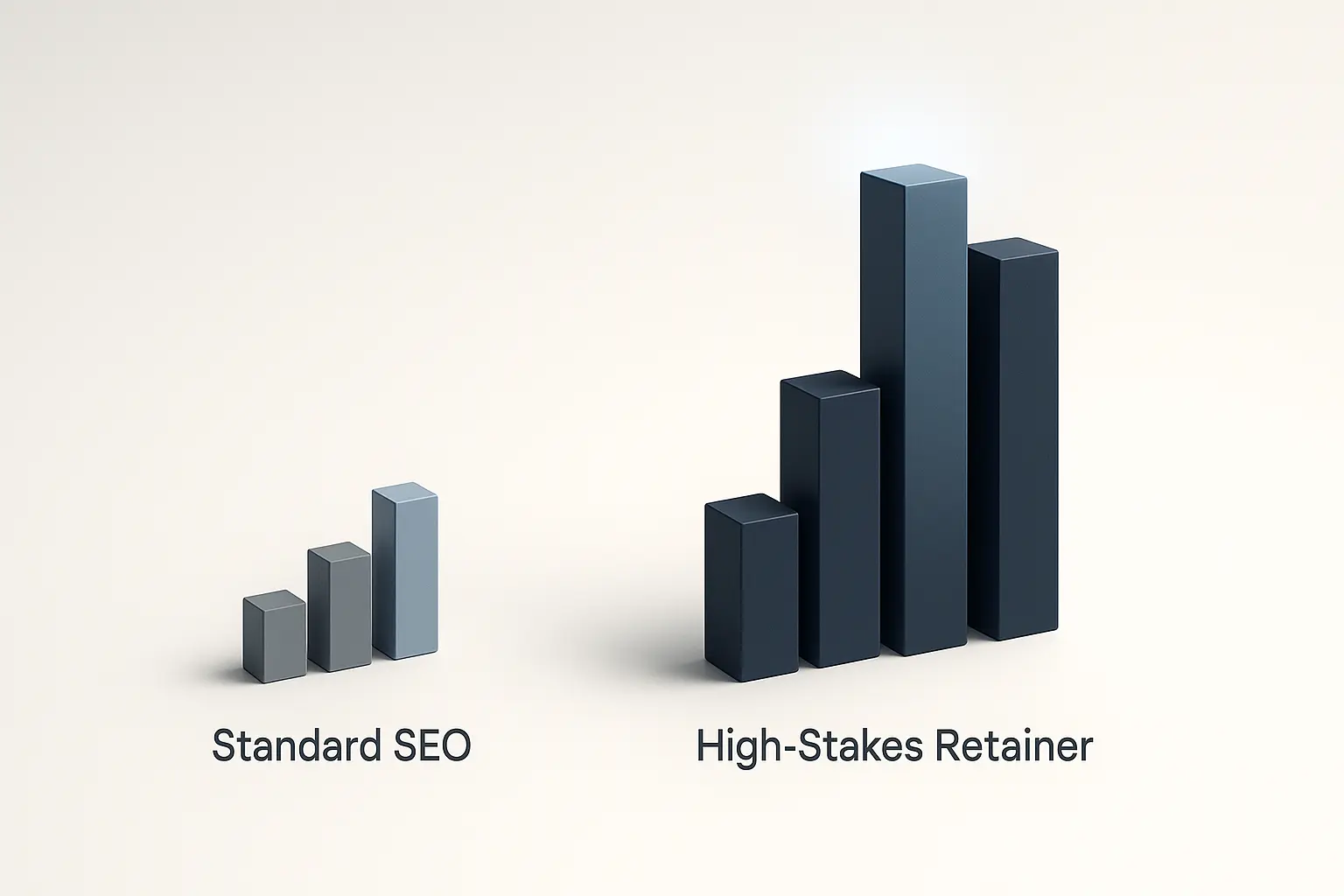You landed the meeting. A multi-location law firm, a fast-growing fintech company, or a B2B SaaS platform—the kind of client that can change the trajectory of your agency.
You nail the pitch, they love your energy, and then comes the question: “So, what does this cost?”
You throw out a number that feels ambitious, maybe double your usual retainer. They agree without blinking. For a moment, you’re euphoric. Then, a slow-dawning dread sets in.
You’ve just promised to win a street fight with a butter knife.
Pricing SEO for high-stakes industries like legal, finance, and SaaS isn’t just about adding a zero to your standard packages. It’s a fundamentally different ballgame, requiring a new approach to budgeting, strategy, and even mindset.
Miscalculating the cost isn’t just a missed opportunity—it’s a recipe for burning out your team, disappointing your client, and losing money on your most important account.
Why High-Stakes SEO Is a Different Game Entirely
What makes these niches so different? It boils down to two factors: competition and customer value.
When the average cost-per-click (CPC) for a term like “personal injury lawyer” can soar past $100, you’re not just competing with other businesses; you’re up against companies with multi-million-dollar marketing budgets. They aren’t just dabbling in SEO—they have entire teams dedicated to dominating the search results.
This isn’t just a challenge; it’s a validation of the potential value. A single client for a law firm or an enterprise customer for a SaaS company can be worth tens or even hundreds of thousands of dollars. The average customer lifetime value (LTV) in the SaaS industry can be over $100,000 for enterprise clients.
When the stakes are this high, a top-ranking position isn’t a vanity metric; it’s a critical revenue channel. Your pricing and your strategy must reflect that reality.
Deconstructing the Premium Retainer: Where Does the Money Go?
So, why does a $10,000/month retainer for a competitive law firm deliver results while a $2,500/month retainer is doomed to fail? The budget allocation tells the story. It’s not about higher margins; it’s about funding a completely different level of activity.
The Content Engine: From Blog Posts to Thought Leadership
In a competitive space, “good enough” content is invisible. High-stakes clients are playing in a world where authority is everything. With over 70% of marketers actively investing in content marketing, your client’s competitors are already publishing. To stand out, you need to create assets, not just articles.
- Standard SEO: A well-researched 1,500-word blog post.
- High-Stakes SEO: A 4,000-word data study featuring original research, interviews with subject matter experts (SMEs), custom graphics, and a corresponding webinar.
This level of content requires a budget for expert writers, graphic designers, and project managers. It’s the difference between renting a billboard and producing a Super Bowl commercial.

Aggressive & Authoritative Link Building
We all know that link building remains a top-three ranking factor for Google. But in high-stakes niches, the quality and velocity of link acquisition are ferocious. Your competitors aren’t just waiting for links to happen; they are actively pursuing them through sophisticated campaigns.
- Standard SEO: Foundational citations, guest posting on relevant blogs.
- High-Stakes SEO: Digital PR campaigns that earn links from major news outlets, targeted outreach to academic institutions, and HARO (Help a Reporter Out) responses from the firm’s top partners.
This requires a dedicated budget for outreach specialists, PR professionals, and potentially paid placement on high-authority industry sites. It’s about building a profile of trust and authority that Google can’t ignore.

Deep Strategic Oversight
In less competitive niches, you can often set a strategy and check in monthly. In a high-stakes environment, the landscape shifts weekly. Your role becomes less of an implementer and more of a strategic partner.
This means more time allocated to:
- Deep Competitor Analysis: Constantly monitoring what top players are doing with their content, links, and technical SEO.
- Conversion Rate Optimization (CRO): Analyzing user behavior on key pages to ensure traffic turns into leads.
- Business Integration: Regular meetings with the client’s sales and marketing teams to ensure your SEO efforts are directly supporting business goals.
Ultimately, a premium retainer is about buying firepower. It’s the necessary fuel for an engine built to win a race, not just finish it.
Shifting the Conversation from Cost to Investment
Once you understand the resources required, your next challenge is communicating that value to the client. The key is to shift the conversation away from your costs and toward their return on investment.
The Power of LTV (Customer Lifetime Value)
Never present a high-ticket proposal without first understanding the client’s LTV. If one new client is worth $50,000 over their lifetime, a $120,000 annual SEO investment seems far more reasonable. It just needs to deliver three new clients over the entire year to break even.
Frame your work in their language:
- “Our goal isn’t just to rank you number one for ‘corporate lawyer.’ It’s to generate qualified inquiries that turn into high-value cases.”
- “Based on an LTV of $100k, we only need to secure one new enterprise client per quarter for this campaign to deliver a 3x ROI.”
Setting Realistic Expectations
High-stakes campaigns are a long game. The brutal truth is that only 5.7% of pages will rank in the top 10 search results within a year of publication. Use this data to your advantage. It helps you combat the inevitable question: “When will we see results?”
Be upfront about the timeline. Explain that the first six months are about building a foundation—fixing technical issues, developing pillar content, and securing foundational links. This upfront investment is what makes ranking possible in months 7-12 and beyond. Anyone promising page-one results in 90 days is either inexperienced or untruthful.

Building Your High-Stakes SEO Package
When structuring your retainer, avoid one-size-fits-all pricing. Offer tiered packages that reflect different levels of aggression and speed.
- Tier 1: Growth Engine ($5,000 – $8,000/mo): Focuses on foundational SEO, one major content asset per quarter, and steady link acquisition. A good entry point for a company serious about competing.
- Tier 2: Market Accelerator ($8,000 – $15,000/mo): Ramps up content production to two major assets per quarter, includes a proactive digital PR component, and adds basic CRO.
- Tier 3: Category Dominance ($15,000+/mo): A fully integrated campaign with weekly strategic calls, a continuous flow of thought leadership content, aggressive multi-channel link building, and deep business intelligence reporting. This is for clients who want to own their market.
Delivering on these packages requires significant operational capacity. If your current team is at its limit, scaling to meet these demands can be a major challenge. This is often when growing agencies explore solutions like finding a dedicated SEO partner to handle the intensive execution, freeing them to focus on strategy and client relationships. For some, a comprehensive AI-driven omnichannel strategy becomes the backbone of their delivery, enabling them to scale without a linear increase in headcount.
Frequently Asked Questions (FAQ)
What’s a typical starting retainer for legal, finance, or SaaS SEO?
While it varies, it’s rare to see effective campaigns in these niches for under $5,000 per month. More commonly, retainers start in the $7,500-$15,000 range, with top-tier national or international campaigns exceeding $25,000 per month.
How do I prove ROI if results take so long?
Focus on leading indicators in the early months. Report on:
- Technical Health Score: Show improvements in site speed and architecture.
- Keyword Movement: Track rankings for a basket of target keywords, even if they aren’t on page one yet.
- Link Acquisition: Report on the number and quality of new backlinks each month.
- Organic Traffic to Key Pages: Show growth in visitors to your new content assets.
What if the client already has an in-house marketing team?
This is often a positive. Frame your service as a force multiplier. You bring specialized SEO expertise and execution power that complements their internal knowledge of the business. You handle the complex, time-consuming SEO work so they can focus on broader marketing initiatives.
Can I offer a one-time project fee instead of a retainer?
You can, but it’s risky for this type of SEO. A one-time project (like a technical audit or content plan) can be a great entry point, but sustainable results in competitive niches require continuous effort. A retainer model aligns your agency’s success with the client’s long-term growth.
Your Next Step in Mastering High-Stakes SEO
Pricing for high-stakes niches is less about finding a magic number and more about building a bulletproof case for value. It requires a deep understanding of the client’s business, a realistic view of the competitive landscape, and the operational confidence to deliver on your promises.
By reframing the discussion from cost to investment and clearly mapping your activities to their bottom line, you can command the retainers you deserve. As your agency grows, the ability to deliver these complex campaigns consistently becomes your biggest challenge. Exploring fulfillment models like SEO outsourcing for agencies can provide the scalable support needed to take on more of these high-value clients without compromising quality.
Start by auditing your own packages. Are they built to win, or just to compete? The answer will determine the future of your agency.

